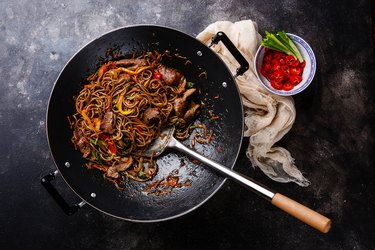
Ever wonder if burned cooking oil is toxic? The consequences of heating cooking oils extend far beyond the immediate risk of burns by splattering hot oil. All oils can withstand varying levels of heat, but overheating can cause cooking oil hazards.
If that level is exceeded, however, the oil not only begins to lose its nutritional value and flavor, it produces toxic fumes and hazardous substances called free radicals. Avoid such risks by choosing an oil suitable for your cooking method.
Video of the Day
Video of the Day
Tip
Over-heating cooking oil can cause toxic fumes and free radicals — hazardous substances that can damage cells.
High-Heat Oils: Temperature Matters
The threshold of heat tolerance is different for all high heat oils, and when it comes to cooking, not all oils are equally desirable or safe.
A heated cooking oil is considered unsafe when it reaches its smoking point — the temperature at which it begins to chemically break down and smoke continuously.
At this point, the fat molecules break down into glycerol and free-fatty acids, and the glycerol breaks down further to produce toxic fumes and free radicals — not to mention an unpleasant flavor.
Choose the Right Oil
The Cleveland Clinic classifies oils in smoke-point categories, such as high, medium-high, medium and no-heat. For example, extra virgin olive oil falls into the medium-high category, and coconut oil falls into the medium category.
The no-heat oils, as their name implies, should not be subjected to heat and instead used for dips and dressings. These include flaxseed and wheat germ oils.
For deep frying, the USDA Food Safety and Inspection Service recommends that you use oils with the highest smoke points. These include peanut, safflower, soybean, grapeseed, canola, corn, virgin olive, sesame and sunflower. These oils have smoke points ranging from 410 to 450 degrees Fahrenheit.
Minimize Free Radicals
Chemical byproducts in the toxic fumes generate free radicals, which are damaged cells. Once inhaled, they have the potential to damage other healthy cells in your body by changing their DNA.
Over time, these damaged cells accumulate and can become precursors to various diseases such as cancer, according to Mayo Clinic.
Health professionals encourage limiting exposure to external free radical sources, such as air pollution, cigarette smoke and fumes from overheated cooking oil —and consuming a diet rich in antioxidants, which is a natural defense against them.
Read more: Canola Oil vs. Vegetable Oil
Follow Safety Precautions
According to the USDA Food Safety and Inspection Service, following certain precautions when heating cooking oil can help prevent injury or fire. If you don't own a deep fryer, the USDA recommends using a deep, heavy skillet instead. Cast iron should be avoided as it breaks down oil faster than other metals.
Don't let your oil come into direct contact with flame — it is highly flammable. Keep a fire extinguisher nearby at all times. When filling your fryer with oil, but sure it is turned off or removed from its heat source and dry. Contact with water can result in extremely hot steam.
Was this article helpful?
150 Characters Max
0/150
Thank you for sharing!
Thank you for your feedback!